Clarke’s Namesake
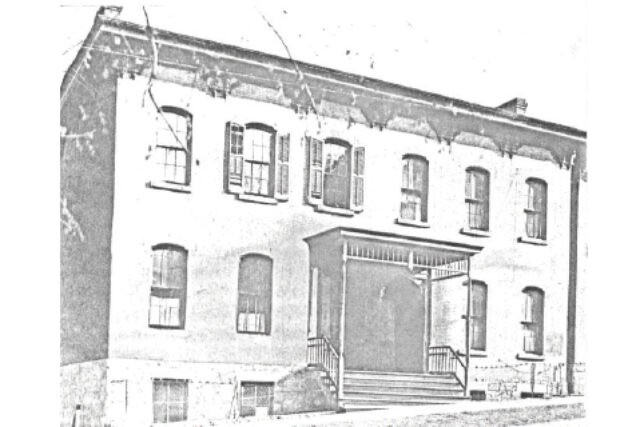
1843
St. Mary’s Female Academy
The first school building, a two-story log structure designed by local architect (a Mr. Gilday), was large enough only for the day students. Mother Mary Frances Clarke served as principal and superior. By fall, more space had been provided at Third and Bluff streets, and a boarding school was opened.
Boarding school expenses at the time included:
Board and tuition (including bed, bedding and washing and payable quarterly in advance) $100
Fuel for the season $1.00
For music, and the use of the Piano (per quarter) $7.00
French language (per quarter) $4.00
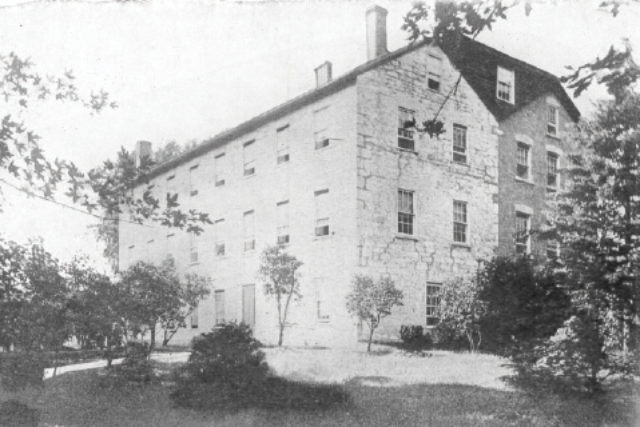
1846
St. Joseph’s Academy on the Prairie
Growth in numbers and the need for space prompted Mary Frances Clarke and Terence Donaghoe to look for other quarters. Land was purchased approximately 10 miles southwest of Dubuque for a school, motherhouse, a novitiate, and a farm, where the sisters could raise their food. The area was called St. Joseph’s Prairie.
In this year, the school was renamed St. Joseph’s Academy and Iowa was awarded statehood.
An advertisement described the Academy location as beautiful and picturesque; the air is pure and healthy. Courses were comprised of Orthography, Reading, Writing, Arithmetic, Grammar, Composition, Elocution, Astronomy and the use of Globes, Algebra, History, Chronology, Mythology, Rhetoric, Chemistry, Botany, French, German, and Spanish languages, Music, and Drawing.
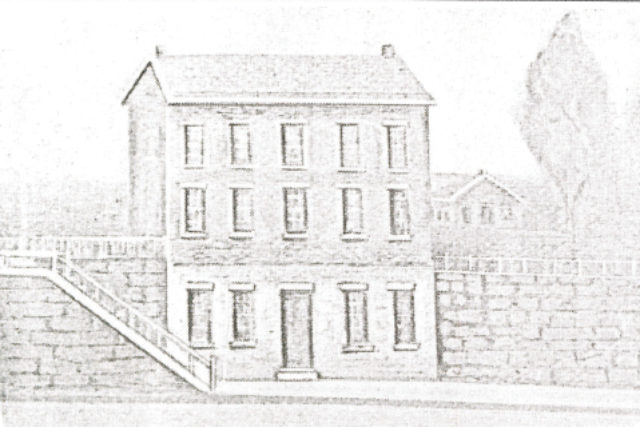
1859
Academy of the Sacred Heart
Roads on the prairie were often impassable. Winter was the best travel time, with speeds on the roads during the cold months of about three and one-half miles per hour. Transportation problems were the chief reason for relocating the school back to Dubuque in 1859, when it was renamed the Academy of the Sacred Heart.
The school functioned in a building on Fourteenth Street. Here the sisters and their students lived through the Civil War years of 1861 to 1865.

1868
Mount St. Joseph’s Academy
The sisters and students moved into the former Wellington mansion at Thirteenth and Main streets. On September 6, 1868, 150 students – day students and boarding students – registered for a new academic year at St. Joseph’s Academy.
The next ten years brought more expansion and very crowded conditions. This prompted Mary Frances Clarke and William J. Knight, a Dubuque lawyer and trusted confidant to search for a more suitable site for another boarding school.
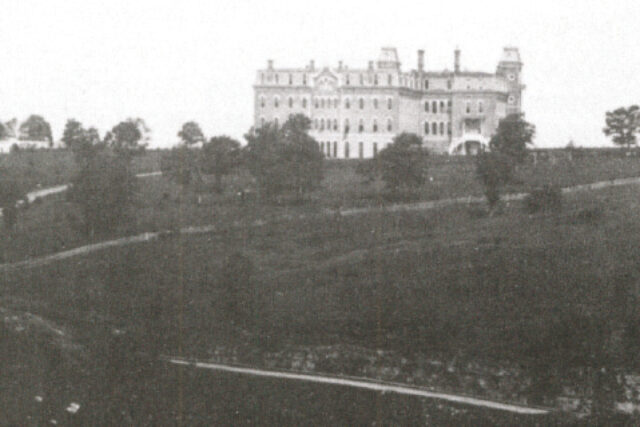
1881
Moved to present location
At the time it was located two miles outside of town on a former mining area for lead. 11 and one-half acres were purchased in the name of Mother Mary Frances Clarke on March 1879 for $200 per acre, and an additional $300 for the mining rights. This land was owned by Michael Carney and Eugene Flynn, who were operating three mines on the land.
William J. Knight assisted Mary Frances Clarke in purchasing the land where Clarke is now located. He also donated 1,000 trees to be planted on campus. He was also chosen by Mother Clarke as legal advisor for the BVM community and by Sister Mary Josephine Clarke as lawyer for the school, he served 49 years, not merely as an attorney-at-law, but also as a dedicated friend and benefactor.
One of the first traditions to be established at the Mount was the Foundress Day Picnic. October 4, the feast of St. Francis of Assisi, has always been celebrated by the BVM community and their students as Mary Frances Clarke’s feast day.
This was the fourth and final location for the school. As the school grew so did its campus. Additional land was secured in 1888, 1912, 1916, and 1962.

1901
Mount St. Joseph College
Mount St. Joseph College began in 1901 as a three-year liberal arts college. It offered two general courses: the English and Classical and the English and Scientific. For the first, French and German would suffice for languages, but Latin and Greek were recommended. Requirements for the second were history, rhetoric, English composition, and Latin, French or German. A Bachelor of Arts was given on completion of of the English and Classical course and a Bachelor of Science was given for English and Scientific course.
In 1901, college board, tuition and course expenses were $85.00. Laundry entailed another $10.00 and use of the library was $1.00 more. Music, art, typing, elocution, laboratory fee, and gymnasium carried extra charges ranging from $1.00-$20.00
Mount St. Joseph College was charted by the State of Iowa in 1910 under the direction of Mary Bertrand Foley, BVM. It was first accredited by the North Central Association of Colleges and Secondary Schools in 1918.
From 1901-1924, the campus expanded to include the College Building, Sacred Heart Chapel, library and Mary Bertrand Hall, as well as Eliza Kelly Hall for music and art and Mary Frances Clarke Hall, which served as a dormitory.
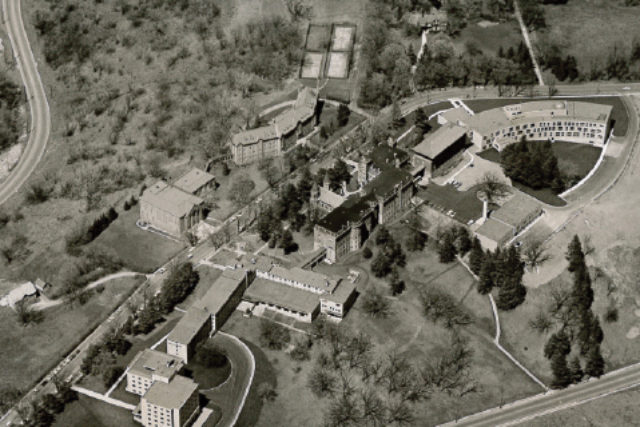
1928 – 2010
Clarke College
Mount St. Joseph’s Academy became Clarke College in 1928. One year later, the Great Depression began in America and Clarke responded to the challenging times by offering limited courses and reducing the number of faculty responsible for courses. As the Depression deepened, the student body manifested increasing earnestness in their study, which was born of the realization that college was not a right, but a privilege.
In 1929, Terence Donaghoe Hall, the physical activity center, and pool were constructed. This was followed in 1952 by a renaming ceremony in which the campus buildings were renamed in honor of those individuals who played vital role in the making of Clarke history. Seminary Street was also renamed Clarke Drive at this time. In 1955, Mary Josita Residence Hall opened followed by West Hall (later Mary Benedict Hall) and the Science Classroom Building (later the ‘new’ Catherine Byrne Hall) in 1966. In 1979, Mary Josita Hall became the co-ed residence hall and remains that way today.
In 1984, the Great Clarke Fire took place and destroyed nearly one-third of the campus. Undaunted, the students hung a banner the very next day proclaiming “Clarke Lives!” Two years later after a vigorous rebuilding campaign, a dedication was held for a new library, music performance hall, chapel, and central atrium, which now constitute the core of the campus in 1986.
In 1994, the Robert and Ruth Kehl Center was constructed as the on-campus recreation and sports complex followed by the Catherine Dunn, BVM Apartment Complex in 1998, and the Student Activities Center in 2000.
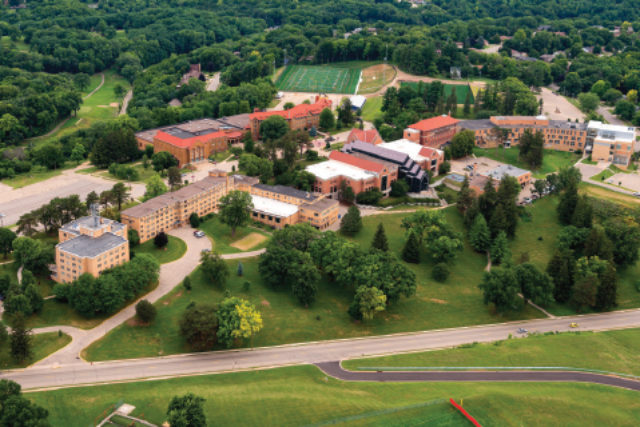
2010 – Present
Clarke University
Clarke College was renamed to Clarke University in an effort to accurately represent the institution’s robust undergraduate and graduate academic programs. Presently, Clarke offers 25 undergraduate majors, four master’s programs, and two doctoral programs.
Since 2010, the campus footprint has continued to evolve and expand. The Lingen Technology Commons- a technology-rich learning space was completed in the lower level of the library in 2012, the Marie Miske Center for Science Inquiry opened in 2013 followed by significant renovations within Catherine Byrne Hall, which include new physical therapy classrooms and laboratories, a food science laboratory, and nursing simulation laboratory. In 2018, new outdoor athletic fields were added in the RC Wahlert Sports Complex along with a new fitness center and locker room facilities in the lower level of the Robert and Ruth Kehl Center.
